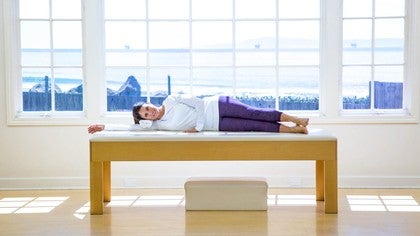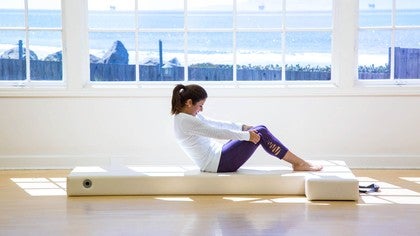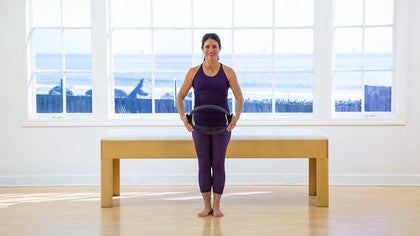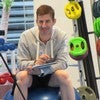Description
About This Video
Transcript
Read Full Transcript
Hi, today I am hoping to give you the tools that you need to do the Let's Get Started series on Pilates Anytime, even if you have a weak neck. I hear a lot, and a lot of questions come my way, about, oh, my neck is starting to hurt, or I'm hurting, and what do I do in this exercise, so I'm hoping to address all those needs and give you all the tools that you need to feel empowered in this Let's Get Started series. First, let's talk about what do I mean by a weak neck? I do not mean it's in its acute stage, where you just injured it, you're seeking medical attention, it's hurting you nonstop, I'm not talking about this. I'm talking more about if you have been advised that you need to strengthen it.
If you have been told you need to strengthen it, strengthen your core to help support it, this is the series for you, and we're gonna talk about how you can safely progress in this series. So, let's get started with getting to know your body, and we're gonna assess your range of motion. So, let's lie down on your exercise mat, and you might need to go down to the floor gingerly, maybe you need to roll to your side when you lie down, and then your knees are gonna be bent, and your feet flat. So we know you have a weak neck, so it's probably not gonna feel good to lift up your head for very long, but let's just assess the rest of our body for good measure, and make sure that nothing else aggravates our neck. You're gonna keep your head down, if you find yourself that you're not able to lie the back of your neck flat, and you look like you're looking behind you, be sure to grab a towel, and fold it up, a bath towel, and put it under your head so that you're able to look at least directly up to the ceiling, and ideally, maybe even towards your knees a little bit would be great to start stretching the back of your neck, 'cause we have a lot of compression in our neck, and we want, in Pilates, to always support and lengthen that area, so ideally, you're even looking more this way, rather than straight up at the ceiling, and certainly not behind you, okay.
Another thing that you might wanna look out for when you lie down on your back is your ribs. If they're really up here, and there's like a tunnel under your ribcage, then you would also want to have a towel, 'cause it's like a seesaw effect. When your head goes up, those will go down. So, that's where you'll wanna start before you assess your body. Now let's check the range of motion in your arms.
Does it bother you to lift up your arm? This might actually send a shooting pain towards your neck, or maybe when the arm goes behind you, does it impinge on your shoulder and neck, and cause pain? What about if you come back, or down, it should be okay, I don't know? Let's start taking notes on our own body and become our own teacher. How 'bout if we lift up the arm, maybe that feels okay, but then it starts to hurt as you open the arm to the side?
Circling down to your hip, did that feel okay? Let's reverse that, how 'bout when we lift this way, maybe that hurts your neck, coming back up? The arms are gonna play a really big role in your neck, you know, that whole thigh bone connected to the hip bone? Your shoulder uses muscles that connect to your neck, and when you lift up your head, same thing, so the arm and the lifting of the head are gonna really affect your neck. Let's try the other arm, so the left, same thing.
Does it hurt to lift up the arm? Does it hurt to take the arm behind you, right up to the ceiling, back down by your side. How 'bout if we did a circle with that arm? We're lifting it up, sometimes we'll be called to do a circle, so opening it to the side, back down to your hip, reversing that circle out to the side, up to the ceiling, down to your hip. Did that feel okay?
You'll wanna start really being your own teacher, taking notes so that you can progress safely. Let's look at our hips, that really shouldn't have any effect on your neck, but it's always important to make sure we rule out anything else hurting or aggravating us, 'cause then, if something else is hurting or aggravating you while you're doing your Pilates work, you're gonna start stressing in your neck, and taking tension. Your neck is a lot about tension, so we wanna make sure nothing else hurts in our body, so let's bend the right knee into your chest, and hug it, how did that feel? Hip okay, knee okay? And what if we straighten the leg, can you put your hands behind your thigh?
Does that hurt your hip, does that hurt your back? What if we put our arms down by your side, and now drew a little circle? So, crossing the body, and draw a little circle in one direction, notice I didn't circle my whole body, just the leg, in the hip joint, reverse it. This is just checking if anything else bothers us while we move, okay, we're gonna bend the knee, and put the foot back down, and do the same with the left. Grabbing the left, felt okay on your hip, or knee, maybe just pulling this in sent tension into your neck and shoulders?
How 'bout straightening the leg, same thing, are we okay with that? And then, what happens, we wanna also take note of your flexibility. How flexible are you right here, is it bent, is it really hard, 'cause you might need to modify a few exercises with how you extend the leg, so that they don't strain your neck. And then, if we have our hands by our side, what about doing a circle with this leg? All right, that way felt okay, maybe not?
And then reversing it, good. And then hugging it in. All right, so we just wanted to check all of those things, how did that feel? Did it cause any extra tension on our neck? Let's start talking about what we can do.
I'm gonna go ahead and roll up. This is more like a tutorial, so we'll be going back and forth. There is so much that you can do with a weak neck, you just kind of have to modify, more than omit, which, when you have a weak back, they're very similar, quite parallel on a lot of the modifications, but you can probably do a lot more with a weak neck. You just have to modify things versus omitting, and we're gonna go over how to modify things in just a moment, but just like a weak back, there are some things you do need to omit. We want to omit all rolling exercises.
Until our neck feels really good, we're going to omit all rolling exercises. The three that you're gonna need to look out for are rolling like a ball, open-leg rocker, and seal. Let me give you a glimpse of what those exercises look. They're not gonna be in the first class. As you make your way through the series, on day 10, and you're doing it intermediate, but by then, you'll see them all, but they will slowly get introduced, and I want you to have an eye out for 'em.
So the first one is rolling like a ball, and you're gonna wanna omit this one. You're gonna be asked to be towards the front of your mat, maybe in the beginning, you'll start with your hands underneath the knees, and then your hands on your ankles, and then we're gonna balance with our feet up in a C-curve. The building blocks for that exercise when I'm going through it are gonna be really similar to the rollback that we'll go through in a second, and all of the building, all of the foundational work is very good for you, and it'll help you gain strength, but don't actually execute rolling like a ball when we get to it. The second one I would like you to omit is open-leg rocker, and that will be balancing again, and this time, your legs will be extended, and your powerhouse in and up. Maybe all of the building blocks of learning how to do this might feel okay on your neck, but certainly not the rolling part, so we're gonna leave that out.
Finally, you'll get to seal, and the hands will be under your ankles, and you'll be asked to roll back and forth like this. Again, any little building or foundational work would be fine, but make sure you don't roll. If you had a weak back, I would say no twisting, and I'm gonna say the exact same thing here, just being a little bit cautious with that neck. Then there are a few twisting exercises I want you to proceed gingerly with. The first one is criss-cross, you might not feel comfortable at anyway lifting your head up to do this exercise, so it might be an easy one for you to omit.
The second one is gonna be the saw, and the third one is corkscrew. I'm gonna give you a glimpse of what those look like so that you can have a little heads-up when we're getting to them in the series. So, the series of five is a fantastic series to build strength in your powerhouse, so you're gonna want to do those, but the last one is called the criss-cross, and your hands will be behind your head, and your knees will be into your chest, and we're gonna end up lifting our head from our powerhouse, and maybe this will end up being okay, this part, but not the twisting. So the twisting is trying to take an elbow to a knee, and then an elbow to another knee. Let's leave that one out until we feel really confident.
The next one that I want you to leave out is saw, and I just roll over to my side. You might feel fine sitting straight up, I'm just giving you a little help in knowing what you can do if you don't. It's a little tool, so here on saw, your arms are gonna be out to your side, and the exercise will call for you to twist your spine, this might feel okay right here, and twisting, but it might not feel okay to twist and to reach forward, so let's just leave this one out until you feel so bored with the other exercises, and so strong that you're able to do that confidently. And then finally, we have corkscrew, so it will look like your back is flat on the mat, your arms will be down, which will be healthy for your neck, your neck will be down, which is helpful for your neck, but if you have tight hamstrings, the whole exercise might strain you too much and pull on your neck. So what happens in corkscrew is the legs are extended up, and you have to draw a circle on the ceiling one way, and then the other way, okay?
But again, if you have tight hamstrings, that might not feel good for your neck. So, those are the three twisting exercises we wanna leave out. Finally, there are some arching exercises that should feel okay, you just wanna be very careful, and try to make sure that you hone in on those details that I mentioned in the intro. It's all in the details, so you really wanna feel your stomach support your lower back, and help roll open your shoulders, anytime I'm talking about how to release tension in your neck and shoulders, really hear those details, try to feel 'em, don't just think you have 'em, but really, really have them. Now, I'd love to show you some tips on what your neck and shoulders might be doing during the exercises, and how to kind of warm up for them.
So, I'm gonna go grab a short box to help support my feet. Shoulder rolls, those are the best for a neck, so we're gonna really try to understand what's happening with our shoulder blades and our shoulders in relationship to our neck and our head. So, I want you to lift, go ahead and actually, you're just sitting in a chair, possibly, that would be the best thing. I grabbed a box, you grab a chair, sit on down, and then just rest with your palms up, that way, you're not using them to help support you, just have your palms up. See if you can have your shoulders directly over your hip bones, and that your belly is pulled in to support you for good posture.
Try to sit up tall, just a little help, but you're gonna learn all of these muscles and all of these details and tips in the series. Let's start by lifting up our shoulders up to our ears. We're really tense, we wanna start like this, be really aware, okay, my shoulders are up, if I did an exercise like this, probably won't feel very good for my neck. Now, open the chest by having the shoulders go back, they're still up, but they're back, and now we're gonna have those shoulder blades slide down towards our tail bone, and then we have a really nice, long neck, they're down, but they're still back. We're gonna keep them down, but now close the chest and bring those shoulders forward.
That's gonna complete our circle, so we're gonna go up to our ears, tense, opening the chest, slide down the shoulder blades, and then close the chest down here. One more in this direction, up to our ears, open those shoulders, down with the shoulder blades, and close the chest, let's reverse that, opening the chest, they're down and back, they're gonna be back and up to our ears, they're gonna be closed, and up, and then down, two more, opening, let those shoulders rise up with tension, forward, and one more time, opening the chest, up to our ears, forward, and down, just really a lot of range of motion in those shoulders. Now let's do one the other way, so we're gonna lift up your shoulders, open the chest, pull your belly in as you slide those shoulder blades down, and hold here. This is the ideal line that we're going to have when we do our Pilates work, okay? I'm gonna talk a lot about rib placement during the series, I'm gonna talk a lot about your arms.
I want you to really take note of all those details to help get your neck stronger. Now, I wanna go over a few modifications that you will want to keep an eye out so you have the proper tools in your belt, so that you can feel really empowered and strong. So obviously, if your neck hurts because we're holding your head up a lot in the exercises, you can leave it down. I will go over those in the first five exercises in just a second. Another thing is how you use your arms.
So, if you are really pulling with them, and lifting the shoulder, it's gonna really hurt your neck, so you want to be careful on how much tension do you put in those arms, okay? Those can really affect and strain your neck. Another thing that you're gonna wanna look out for is how you lift your head to your chest. Do you squash it like this? Technically, you should almost have like a lemon or a lime right here, so you wanna lift the head long out of your spine, and then bring it up forward, and I'll show you this one lying down, and you still are gazing towards your belly, but a little lemon or a lime underneath your chin instead of squishing it, okay?
So, really important things. So let's talk about how we lift our head and our rib placement. I'm gonna be going over this in a lot of detail in your Let's Get Started beginner series, but it is so crucially important for you, having a weak neck, to really understand, that I wanna go over it with you right now and take some time with that. So I love thinking about our neck, and you don't need to do this with me, you can just watch it as a tutorial, 'cause it might aggravate or hurt your neck while you're watching me. What I love to do is think about our head like a bowling ball, it literally weighs eight to 10 pounds, and I like to think about it as a seesaw, so here is my chest bone, here's the bottom of my chest bone, here's the top of my head.
If the top of my head comes up, the chest bone needs to go down, and so, here are these two points, if my head comes up, my chest bone goes down, and vice-versa, if my head goes down, my chest is gonna come up. So what that looks like is, I'm gonna show you now and again, you might not wanna do it to not aggravate your neck, but I'm gonna pull my belly in, and this is gonna go down as I pull my head up, I hope I was able to show that, and I'm gonna show it to you one more time with my arms up so you can also see that underneath my ribcage, or the bottom of my shoulder blades, if there was any space there, it's gonna go away right now. I'm gonna pull in, and that area's gonna expand as I lift my head, and I'm really secured, and rooted into there. If I had my head even slightly like this, it's so much strain. You're asking your poor little neck to hold the eight to 10 pounds of your head, it's gonna hurt like crazy, so you really want to feel like your bowling ball head is being supported, almost as if you could get it into your stomach, that's how much forward you're gonna be.
Okay, not higher, off of the shoulder blades, but just at the base of the shoulder blades. When you get tired in this position, maybe it's only two counts, you'll lower your head down, okay, super important, don't fight through it. The next time you come to the class, if you fought through it, you're not gonna wanna do it because it hurt, and that'll make you give up on the series, and we don't want that, we wanna stay positive. So keep your head up in the right position only as long as you can do it. All right, so I hope that makes a lot of sense on how to hold up your head.
The other part we talked about was the lemon, so again, I don't need you lifting up and squishing like this, that's not gonna get the weight of your head over your powerhouse. You're gonna want that seesaw effect, it's gonna go down, and you're gonna come up, and the weight of your head's here, a little bit of space there, and we're gonna come down. Okay, why don't we start doing some exercises to see what it feels like with the beginner series? The first exercise you're gonna come to is the 100. So, you'll be taught how to bend your knees into your chest, and how, with your knees just bent, then pump your arms up and down.
What is that gonna mean to you? Well, if I have a bad neck, that might start creeping up like this, right? So you're gonna wanna think about those shoulder rolls, and pull those shoulders away, and keep your vision a little bit more like this, right, not behind you. Hopefully, that's gonna help to stretch your neck, and keep the tension out of your neck and shoulders, and maybe you even feel strong enough to lift your head up like I just showed you, and do a couple counts, and then bring it down for a couple counts, and then maybe leave it for awhile, maybe a couple classes, and after a few classes, maybe you'll be able to hold your head up longer, maybe 50 counts, and then you'll have to lower it down for 50 counts, and then maybe after a few classes, you're gonna get so strong that you can also straighten the legs, so at first I'm gonna lift my head up, and then maybe you can straighten your legs. They're not gonna go straight up to the ceiling, they're gonna go just shy, okay?
If that is too much tension, keep your knees bent. Only straighten your legs a little less than straight up to the ceiling when you feel strong enough, and it's not adding extra pressure or tension. Now, say you, your neck didn't like any of the 100, no one really loves 100 anyway, but say you didn't like the 100 at all, pumping those arms aggravated your neck, there's another thing that you can do. You can open and close your legs 100 count times, which I think is very challenging, but if you have a little more flexibility, in other words, when you checked your range of motion, able to hold your legs straight, or maybe even a little closer to you, then this might be an option for you. If you couldn't even hold your leg up, I wouldn't try it, I would just keep my head down and pump my arms up and down by my side.
So, if you do have flexibility, though, you can keep your arms grounded, pull your belly in, and a nice modification is inhale, two, three, four, five, and exhale two, three, four, five, and inhale, two, three four, five, and exhale, all right, so that's a modification if you really still wanna challenge your stomach, but you absolutely don't feel good about lifting your head at all. Okay, the next exercise that we will come to in the series is the rollback, I'm gonna roll to my side to sit up. Now, the rollback is so great to start building strength in your powerhouse, but if you hunch your shoulders, or if you use your arms in a way that creates tension, it's gonna undo any good work, right? So we wanna keep it positive and good, so keep those shoulders down, feel those shoulder blades relax, and just try to lift the elbows up, and you're gonna keep all of this in mind when we're doing the first class. You're gonna end up pulling your belly back, and then scoop it in.
I hope you see that I'm not trying to give you a workout right now, I'm just trying to give you some tips of how to approach the workout when you're doing the series. So, no tension in those shoulders, light arms, and just trying to get the pulling in the belly. Another thing that might hurt your neck is here, how much do you pull your head forward, right, we talked about the lemon, so maybe just look straight ahead, maybe that'll help you as you pull your waist back, back, back, and then keep pulling your waist back as you come forward. This'll help take the neck out of the equation, and then you can feel good about moving forward and getting stronger. The next exercise in the first class will be single leg circles.
You shouldn't have any problems with that, your head's gonna be down, and you're gonna just circle the leg one way, and then five times the other way, and same thing with this leg. Because your head's down and no arms are involved, you should be able to do this really safely, and that's great news, because that is what you can do, you can strengthen your stomach, learn about barbershop core muscles. When the rest of your body gets strong, your neck will get strong, too. The following exercise one day will be rolling like a ball, you're omitting that, and then you're gonna do single leg stretch. So, single leg stretch, there are some arms in the beginning when you hug in.
If you hug in like this, you're gonna create tension, so make sure you're aware of that. Okay, you wanna pull the leg in with your stomach, the hands are actually just an extra stretch, okay? Now, after a little bit, I'll ask you to lift your head, and do it with your head up. If you can do maybe one set with your head up, great, and then maybe the next set, you have to have your head down, because it doesn't feel good to have your head up longer, and then you can return to that, pulling your belly in like a seesaw, and then after a little while, we're gonna work with opposition, and you're going to straighten the leg that's not bent, and so it's gonna be a little bit just shy of the ceiling. And you might be able to do this with the head up for just one set, and then you have to lie down again, and you're able to do it like this, with your head down, all good things, do it so much until you're bored, and you're like, I can totally do this with my head up, and I feel like my stomach's working, and I'm secure, so again, don't pull with the shoulder, keep those shoulders away, and use your powerhouse to pull into your back, and keep your head down when it starts to feel tired, the neck.
The next exercise will be double straight leg, and we are going to end up doing a few different things here. So, I will teach you how to have your hands behind your head, and how to lift your head up properly like that seesaw. But what happens if just putting your hands behind your head hurts you? You don't need to have your hands behind your head then, you can just have your hands here, or just watch for that two second part, and join in for the rest, okay? But, when I pad the hands behind your head, I'm gonna talk a lot about the proper placement as if there's a spike behind your upper back, and that's really important, because you wanna be up on the base of your shoulder blades, you don't wanna be back here, and the worst thing you can do in this exercise is to go down and up, and down and up throughout the exercise.
The double leg stretch is meant for you to stay right here, so the first part that I teach you is how to stay there, and how to move the arms without going anywhere, so you don't wanna go back and forth and back and forth, that just hurts, and a lot of motion, and needless, and so you're gonna learn how to keep up, but if it bothers you to hold your head up on that exercise, you can completely do it like this, where your arms and legs, and then you pull it, and your neck just stays down, until you really feel, once again, like you've done it so many times, you feel that you can finally do it with your head up, and you might do it maybe just like this in the beginning, that's a great modification for you if you don't take the tension in your neck and shoulders, and then maybe you can advance to going here, okay? So, we're gonna take it little by little so that your neck feels like it's getting introduced to those exercises little by little, and the final exercise you're gonna do in the first class is the spine stretch forward, and we're gonna do it as if we had a weak back, which I like to do it with the hands just on the legs instead of up here, because if your arms are up here, then you might do this, right? And we don't wanna do that when we think about our shoulder rolls, but just to be safe until we're really feeling confident, I want you to slide your hands, as your head comes down, and you slide, you're stretching forward for spine stretch forward. You're gonna slide your hands, and simultaneously slide 'em back too as you roll up your back. This, at times, can cause a lot of pain in your neck, though, so be careful not to crunch, okay?
That might hurt you, so just be kind of a little less dramatic about it and just softly bringin' the head down, think about your spine, definitely pull your belly in, pull your belly in, and pulling it in to roll up, and once you feel really good about that, then your arms will be able to be lifted, and you'll be able to do the exercise with your arms up, and not losing all the shoulder blades and are out of joint. It should feel like a great stretch for your back, really nice. There's just one more modification I wanna give you, and that's for the side kick series. I'm gonna grab a towel, just to show you, you don't need to grab one, but you'll be lying on your side. It's gonna be a great, challenging series for you, and you can do it, no problem.
However, I call for your elbow to be here, nice and long, let's stretch it out (exhales loudly), and then you're a straight line from your elbow to your feet, you'll end up bringing your feet forward at a 45 degree angle, okay? But this might be no bueno for you, so you can fold up a towel, and you can extend your arm, and you can place this towel here, and then your neck will be supported more in line with the rest of your spine when you're doing your side kick series, so just another little tool to keep in your tool belt to feel good about your Let's Get Started beginner series. It doesn't feel good to do any of the exercises when your neck hurts, so I hope that you really felt the shoulders relaxing, and understood how to lift up your head. I'm gonna go into it in big detail during the whole Let's Get Started series, so don't be afraid if you didn't quite get it right here, you don't wanna feel it, and I talk a lot in the first class, and throughout the series, so you'll have plenty of time. And in the end, what's super important is as you strengthen all of your body, you're gonna end up having this great tower of strength, and that's what Pilates is.
We don't just strengthen the neck, we strengthen the whole body, and that supports it, and what that's gonna do is it's gonna end up making your posture look beautiful, so you'll learn how to hold your weight on the ball of your foot, side of the foot, and the heel, how to have a lift in your arch. How to have your weight more on the ball of your foot, how to lift up your inner thighs, the hamstrings, the glutes, so that you just start having this ripple effect from your strong foundation pulling in and up, your upper back's not gonna hang. You're gonna end up learning how to have it forward, and that'll make you look like you are a marionette, being pulled up by a string, and your neck's going to be able to move freely because you have this great, strong, powerful body. I hope that gives you the tools and the tips you need to proceed successfully with the Let's Get Started even though you have a weak neck. I know you can do it.
Tips for Teachers: Working with Contraindications
Comments
You need to be a subscriber to post a comment.
Please Log In or Create an Account to start your free trial.




















